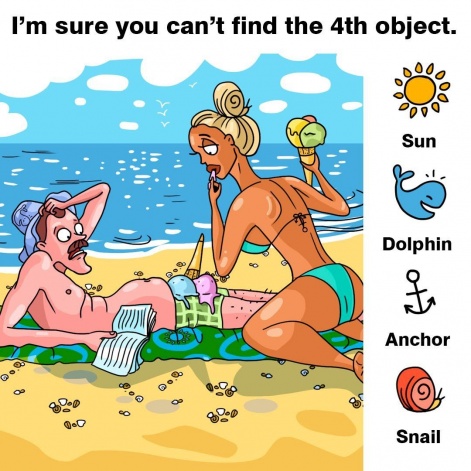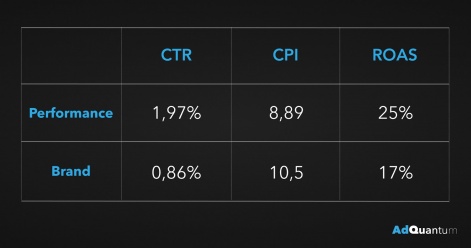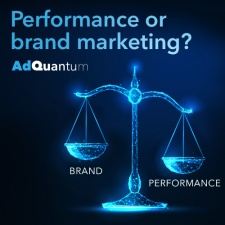A wide variety of clients come to performance marketing agencies. Some of them prepare accurately calculated metrics, clear expectations and a well-defined budget. Others have not yet determined their marketing goals. In the face of this uncertainty, they often confuse effective marketing with brand marketing. In this article AdQuantum’s experts analyse similarities and differences of both these marketing directions and explain why there is no need to choose between them.
Goals of brand and performance marketing
Performance marketing is often perceived as an alternative to brand marketing. In fact, these two directions answer different requests. Globally, marketing in a company is meant to help increase its profit. The most effective way to do this is to attract the target audience (TA) to the product. Therefore, the overall goal of both brand and performance marketing is to attract as many target customers as possible.
Brand marketing focuses on qualitative factors: it strengthens brand image and increases loyalty to it, creates lasting associations and appeals to the vivid emotions of the consumer.
The brand is built over the years, it is not so easy to earn the client’s trust. Therefore, brand marketing’s achievements are evaluated mainly in the long term, they can also have a delayed effect.
Performance marketing achievements are measured by specific quantitative factors: profit, attracted leads, number of sales and clicks, or other conversions. The main distinctive feature of efficient performance marketing is that it is oriented towards obtaining profit right here and right now.
Look at the example from our practice: we designed performance creatives for a 5 differences online app. We also received data on the brand campaigns from the client’s team.

In the performance creative, we used neither the logo, nor brand colours – no brand identity at all. When designing this creative, we aimed at the app target audience consisting of women 25+ who love puzzles. We created a bright, attention-grabbing picture. You need to look at it accurately to find all the hidden figures.

In a brand creative everything is vice versa: you can see both the app’s brand colours (purple and pink) and the large logo in the middle of the creative. Below – metrics for both creatives:

CTR stands for CTR, or click-through rate. This metric allows us to objectively assess rationality of the advertising costs. The higher this metric is, the cheaper each click on the ad will be for the marketer.
CPI (cost per install) indicates how high the cost of acquiring new users through app installs is for a marketer. In case post-install metrics stay at the same level, then the lower the CPI, the better it will be for the mobile marketer, since more money has been saved. With this metric, we can evaluate the success of the campaign.
ROAS stands for Return On Ad Spend. It can be used to calculate income in relation to ad investment.
Performance creatives for 5 Differences Online gave us better metrics. As for brand creatives, fewer users converted from them – therefore, one download with such creatives turned out to be more expensive. The reason is that brand creatives are not initially aimed at call to action. Therefore, the specific impact of brand campaigns is more difficult to assess.
Why you need performance marketing
In performance marketing, it is much easier to measure the impact of advertising, because performance relates to specific data. Its distinctive features are:
- Results in numbers
- Results here and now
- Call to action
- Pay for profit, not for work
You pay not for the work done, but for the result you get. Some performance agencies, for example, use a revenue-share model in their work. This means the agency covers all marketing costs, including the creatives production – and clients just pay them a portion of the profits generated for them. This model ensures that your marketing budget is not wasted.
We are not responsible for the impression of the brand made by our creatives, because a loyal user doesn’t always = a paying customer. We chase the result: app installation, registration, purchase, etc.
How to work with a performance marketing agency
When AdQuantum enters into a contract with a client app, we arrange beforehand what exact numbers need to be achieved (KPIs). Creatives are initially designed for specific goals and results. And we immediately, even on the same day, are likely to see the result displayed in the metrics.
At the beginning of cooperation with the app, first of all, we fully explore the product: its specifics, audience, competitors’ works and other details.
Then we formulate hypotheses of advertising creativity, which designers and project managers help us to realise. The hypotheses have been formulated, the creatives are ready – now we are starting A/B testing.
Testing in performance marketing is essential since it helps find the most effective solutions. The point of A/B testing (or split testing) is that the audience is randomly divided in half. One set of users get a standard creative, another set – a modified creative. We are going to compare results from both creatives, allowing us to evaluate how successful changed creatives are.
As a result, we have a certain – always different – number of best creatives. We launch them on different traffic sources: Google Ads, Facebook, Instagram, Unity Ads, TikTok, etc. Ideally, it is necessary to test creatives for each new source, since each of them has a specific TA and content consumption model.
Launching creatives is like serving food in a restaurant. We launch one creative variation, see how it works, test it, analyse the metrics for compliance with the main criteria – then launch the next one. When we have collected enough data, we determine creatives that have the best results – the highest “performing” of them all. In order to “drive” metrics, a creative should comply with certain rules. Let’s figure out which ones.
How to design a performing creative
In order to produce an efficient creative, first of all determine the app’s TA.
Let’s assume our agency started cooperation with a storytelling app. Its TA consists of women aged 25+ who enjoy reading love stories. Typically, such an audience is interested in the romantic relationships topic.
Our client sees long beautiful videos without a specific idea as ad creatives. From our experience, we know that this kind of creative would not attract our potential user’s attention — thus, the creative will not call them to take the target action. The idea of the creative should be relevant, it should solve the user’s problem or need as they come to the app.
Therefore, we create a short video where the sweetest moment of a romantic relationship unfolds. In a creative we show a potential user the quintessence of what he will receive from a product. It is acceptable that the creative will not completely match the story from the app. We can add something new and potentially interesting for our TA or exaggerate the moments provoking empathy: pity, curiosity, fear. Resorting to vivid emotions increases user retention. When designing this kind of creatives it is not necessary to use a brand book. It does not guarantee that we will attract the user’s attention or call them to download the app.
Combining performance and brand marketing
There also have been some cases when the performance creative became so viral that it raised brand awareness – thus, turned out to be a brand creative as well. One of these cases is with the mobile game Idle Evil Clicker, a game about torture in hell. For this app, we made a creative with a torture which did not yet exist in the game. High ad metrics inspired Red Machine developers to add this feature to the product. This is an example of unintentional production of both brand and performance creative. Typically, for these purposes two different departments are involved in the operation.

In the case that there is a negative impact on brand image from a performance creative, we take corrective measures promptly. Despite the fact that such situations are often only a matter of perception, if there is an opinion that our performance campaign damages a brand image, we stop it in agreement with the client.
Why not choose?
Brand and performance marketing are equally important to a company’s success. Sometimes these two directions can conflict if you do not fully understand their goals. However, for the long-term success of a company, you need a strategy combining both performance and brand marketing.
AdQuantum will not fulfil the brand marketing mission 100 per cent. However, we guarantee acquiring users to your app, increasing downloads and ultimately increasing your revenue in the shortest possible time. Get in touch with us for more details!

